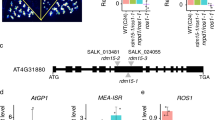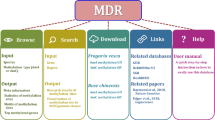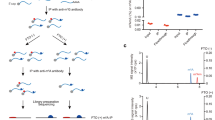Abstract
DNA N6-methyladenine (6mA) is a non-canonical DNA modification that is present at low levels in different eukaryotes1,2,3,4,5,6,7,8, but its prevalence and genomic function in higher plants are unclear. Using mass spectrometry, immunoprecipitation and validation with analysis of single-molecule real-time sequencing, we observed that about 0.2% of all adenines are 6mA methylated in the rice genome. 6mA occurs most frequently at GAGG motifs and is mapped to about 20% of genes and 14% of transposable elements. In promoters, 6mA marks silent genes, but in bodies correlates with gene activity. 6mA overlaps with 5-methylcytosine (5mC) at CG sites in gene bodies and is complementary to 5mC at CHH sites in transposable elements. We show that OsALKBH1 may be potentially involved in 6mA demethylation in rice. The results suggest that 6mA is complementary to 5mC as an epigenomic mark in rice and reinforce a distinct role for 6mA as a gene expression-associated epigenomic mark in eukaryotes.
This is a preview of subscription content, access via your institution
Access options
Access Nature and 54 other Nature Portfolio journals
Get Nature+, our best-value online-access subscription
$29.99 / 30 days
cancel any time
Subscribe to this journal
Receive 12 digital issues and online access to articles
$119.00 per year
only $9.92 per issue
Buy this article
- Purchase on Springer Link
- Instant access to full article PDF
Prices may be subject to local taxes which are calculated during checkout






Similar content being viewed by others
References
Fu, Y. et al. N 6-methyldeoxyadenosine marks active transcription start sites in Chlamydomonas. Cell 161, 879–892 (2015).
Greer, E. L. et al. DNA methylation on N 6-adenine in C. elegans. Cell 161, 868–878 (2015).
Zhang, G. et al. N 6-methyladenine DNA modification in Drosophila. Cell 161, 893–906 (2015).
Koziol, M. J. et al. Identification of methylated deoxyadenosines in vertebrates reveals diversity in DNA modifications. Nat. Struct. Mol. Biol. 23, 24–30 (2016).
Liu, J. et al. Abundant DNA 6mA methylation during early embryogenesis of zebrafish and pig. Nat. Commun. 7, 13052 (2016).
Wu, T. P. et al. DNA methylation on N 6-adenine in mammalian embryonic stem cells. Nature 532, 329–333 (2016).
Mondo, S. J. et al. Widespread adenine N 6-methylation of active genes in fungi. Nat. Genet. 49, 964–968 (2017).
Wang, Y., Chen, X., Sheng, Y., Liu, Y. & Gao, S. N 6-adenine DNA methylation is associated with the linker DNA of H2A.Z-containing well-positioned nucleosomes in Pol II-transcribed genes in Tetrahymena. Nucleic Acids Res. 45, 11594–11606 (2017).
Yao, B. et al. DNA N 6-methyladenine is dynamically regulated in the mouse brain following environmental stress. Nat. Commun. 8, 1122 (2017).
Ye, P. et al. MethSMRT: an integrative database for DNA N 6-methyladenine and N 4-methylcytosine generated by single-molecular real-time sequencing. Nucleic Acids Res. 45, D85–D89 (2017).
Legrand, C. et al. Statistically robust methylation calling for whole-transcriptome bisulfite sequencing reveals distinct methylation patterns for mouse RNAs. Genome Res. 27, 1589–1596 (2017).
Tan, F. et al. Analysis of chromatin regulators reveals specific features of rice DNA methylation pathways. Plant Physiol. 171, 2041–2054 (2016).
Li, X. et al. High-resolution mapping of epigenetic modifications of the rice genome uncovers interplay between DNA methylation, histone methylation, and gene expression. Plant Cell 20, 259–276 (2008).
Zhang, T., Zhang, W. & Jiang, J. Genome-wide nucleosome occupancy and positioning and their impact on gene expression and evolution in plants. Plant Physiol. 168, 1406–1416 (2015).
Sasaki, S. et al. Chromatin-associated periodicity in genetic variation downstream of transcriptional start sites. Science 323, 401–404 (2009).
Zemach, A., McDaniel, I. E., Silva, P. & Zilberman, D. Genome-wide evolutionary analysis of eukaryotic DNA methylation. Science 328, 916–919 (2010).
Li, X. et al. Single-base resolution maps of cultivated and wild rice methylomes and regulatory roles of DNA methylation in plant gene expression. BMC Genomics 13, 300 (2012).
Wang, Y., Wang, X., Lee, T.-H., Mansoor, S. & Paterson, A. H. Gene body methylation shows distinct patterns associated with different gene origins and duplication modes and has a heterogeneous relationship with gene expression in Oryza sativa (rice). New Phytol. 198, 274–283 (2013).
Su, Z., Han, L. & Zhao, Z. Conservation and divergence of DNA methylation in eukaryotes: new insights from single base-resolution DNA methylomes. Epigenetics 6, 134–140 (2011).
Lee, T.-F., Zhai, J. & Meyers, B. C. Conservation and divergence in eukaryotic DNA methylation. Proc. Natl Acad. Sci. USA 107, 9027–9028 (2010).
Niederhuth, C. E. et al. Widespread natural variation of DNA methylation within angiosperms. Genome Biol. 17, 194 (2016).
Feng, S. et al. Conservation and divergence of methylation patterning in plants and animals. Proc. Natl Acad. Sci. USA 107, 8689–8694 (2010).
Kohli, R. M. & Zhang, Y. TET enzymes, TDG and the dynamics of DNA demethylation. Nature 502, 472–479 (2013).
Zhu, C. & Yi, C. Switching demethylation activities between AlkB family RNA/DNA demethylases through exchange of active-site residues. Angew. Chem. Int. Ed. Engl. 53, 3659–3662 (2014).
Yu, B. et al. Crystal structures of catalytic complexes of the oxidative DNA/RNA repair enzyme AlkB. Nature 439, 879–884 (2006).
Sundheim, O. et al. Human ABH3 structure and key residues for oxidative demethylation to reverse DNA/RNA damage. EMBO J. 25, 3389–3397 (2006).
Yang, C.-G. et al. Crystal structures of DNA/RNA repair enzymes AlkB and ABH2 bound to dsDNA. Nature 452, 961–965 (2008).
Feng, C. et al. Crystal structures of the human RNA demethylase Alkbh5 reveal basis for substrate recognition. J. Biol. Chem. 289, 11571–11583 (2014).
Pastore, C. et al. Crystal structure and RNA binding properties of the RNA recognition motif (RRM) and AlkB domains in human AlkB homolog 8 (ABH8), an enzyme catalyzing tRNA hypermodification. J. Biol. Chem. 287, 2130–2143 (2012).
O’Brown, Z. K. & Greer, E. L. N 6-methyladenine: a conserved and dynamic DNA mark. Adv. Exp. Med. Biol. 945, 213–246 (2016).
Langmead, B., Trapnell, C., Pop, M. & Salzberg, S. L. Ultrafast and memory-efficient alignment of short DNA sequences to the human genome. Genome Biol. 10, R25 (2009).
Zhang, Y. et al. Model-based analysis of ChIP–seq (MACS). Genome Biol. 9, R137 (2008).
Flusberg, B. A. et al. Direct detection of DNA methylation during single-molecule, real-time sequencing. Nat. Methods 7, 461–465 (2010).
Zhang, J. et al. Extensive sequence divergence between the reference genomes of two elite indica rice varieties Zhenshan 97 and Minghui 63. Proc. Natl Acad. Sci. USA 113, E5163–E5171 (2016).
Lim, J.-Q. et al. BatMeth: improved mapper for bisulfite sequencing reads on DNA methylation. Genome Biol. 13, R82 (2012).
Li, H. et al. The sequence alignment/map format and SAMtools. Bioinformatics 25, 2078–2079 (2009).
Kim, D. et al. TopHat2: accurate alignment of transcriptomes in the presence of insertions, deletions and gene fusions. Genome Biol. 14, R36 (2013).
Zhang, W. et al. High-resolution mapping of open chromatin in the rice genome. Genome Res. 22, 151–162 (2012).
Mielecki, D. et al. Novel AlkB dioxygenases—alternative models for in silico and in vivo studies. PLoS ONE 7, e30588 (2012).
Lei, Y. et al. CRISPR-P: a web tool for synthetic single-guide RNA design of CRISPR-system in plants. Mol. Plant 7, 1494–1496 (2014).
Li, J., Sun, Y., Du, J., Zhao, Y. & Xia, L. Generation of targeted point mutations in rice by a modified CRISPR/Cas9 system. Mol. Plant 10, 526–529 (2017).
Otwinowski, Z. & Minor, W. Processing of X-ray diffraction data collected in oscillation mode. Methods Enzymol. 276, 307–326 (1997).
Adams, P. D. et al. PHENIX: a comprehensive Python-based system for macromolecular structure solution. Acta Crystallogr. D Biol. Crystallogr. 66, 213–221 (2010).
Emsley, P., Lohkamp, B., Scott, W. G. & Cowtan, K. Features and development of Coot. Acta Crystallogr. D Biol. Crystallogr. 66, 486–501 (2010).
Acknowledgements
We thank Y. Zhao for providing the Cas9–single gRNA system, the staff from BL17U/BL19U1/beamline of the National Centre for Protein Sciences Shanghai (NCPSS) at the Shanghai Synchrotron Radiation Facility for assistance during data collection, and the research associates at the Centre for Protein Research, Huazhong Agricultural University, for technical support. This work was supported by funds from the National Key Research and Development Program of China (2016YFD0100802), the National Science Foundation of China (grants 31730049, 31571256 and 31270787), the Program for New Century Excellent Talents in University (NCET-13-0811), the Fundamental Research Funds for the Central Universities (programme no. 2662015PY228, 2013PY063 and 2014PY017), and supported by Huazhong Agricultural University Scientific and Technological Self-innovation Foundation (programme no. 2016RC003).
Author information
Authors and Affiliations
Contributions
C.Z. performed the experiments to analyse rice genome-wide 6mA. C.W. and T.P. performed the molecular cloning and enzyme assays. H.L. conducted the 6mA mass spectrometry analysis. Q.L. and Y.Z. participated in sampling and experimentation. Y.G., T.P. and Z.Z. performed protein purification, crystallization, X-ray data acquisition and structure refinement and analysis. D.-X.Z., C.Z., Z.Z., Q.Z., J.S., J.Z. and L.C. analysed the data. D.-X.Z. coordinated and supervised the project and wrote the paper with input from C.Z. and Z.Z.
Corresponding authors
Ethics declarations
Competing interests
The authors declare no competing interests.
Additional information
Publisher’s note: Springer Nature remains neutral with regard to jurisdictional claims in published maps and institutional affiliations.
Supplementary information
Supplementary Information
Supplementary Figures 1–6 and Supplementary Tables 1–5.
Rights and permissions
About this article
Cite this article
Zhou, C., Wang, C., Liu, H. et al. Identification and analysis of adenine N6-methylation sites in the rice genome. Nature Plants 4, 554–563 (2018). https://doi.org/10.1038/s41477-018-0214-x
Received:
Accepted:
Published:
Issue Date:
DOI: https://doi.org/10.1038/s41477-018-0214-x
This article is cited by
-
DNA methylation on C5-Cytosine and N6-Adenine in the Bursaphelenchus xylophilus genome
BMC Genomics (2023)
-
A DNA adenine demethylase impairs PRC2-mediated repression of genes marked by a specific chromatin signature
Genome Biology (2023)
-
Navigating the pitfalls of mapping DNA and RNA modifications
Nature Reviews Genetics (2023)
-
Regulatory roles of epigenetic modifications in plant-phytopathogen interactions
Crop Health (2023)
-
NT-seq: a chemical-based sequencing method for genomic methylome profiling
Genome Biology (2022)



